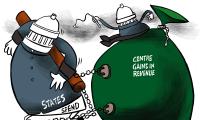India's Private Capital Expenditure to Pick Up: MPC Member
RBI MPC member Jayanth R Varma predicts increased private capital expenditure in coming years, citing rising capacity utilization and government's infrastructure investments.

Illustration: Dominic Xavier/Rediff.com
New Delhi, Jan 16 (PTI) RBI Monetary Policy Committee (MPC) member Jayanth R Varma has said that capacity utilization has been slowly increasing and private capital expenditure would pick up in the coming years.
Varma further noted that in the last couple of years, the government has shouldered the burden of investment, while private capital expenditure has been muted.
"At the same time, capacity utilization has been slowly creeping up and it is approaching levels that prompt the private sector to undertake capital expenditure at least in some sectors," he told PTI.
Moreover, Varma, a professor at the Indian Institute of Management, Ahmedabad said large public sector infrastructure investment of the recent years has the potential to crowd-in private sector investments.
"On the whole, I am hopeful that private capital expenditure would pick-up in the coming years, and pick-up the baton from the public sector," he said.
Asked whether India can escape the middle income trap, Varma said it is imperative that India makes this transition because failure would be extremely painful for the country's vast population.
Moreover, "the task is not easy as it would require a growth rate of 7-8 per cent sustained over many decades, and not many countries have done this successfully," the MPC member said, adding that he is very optimistic that India as a nation can overcome this challenge.
Noting that India's democratic polity makes governments responsive to the needs and aspirations of its people, Varma said over the decades, India has created the capabilities both in private and public sector to surmount the obstacles that will surely arise in this path.
The middle-income trap captures a situation where a middle-income country can no longer compete internationally in standardized, labor-intensive goods because wages are relatively too high, but it also cannot compete in higher value-added activities on a broad enough scale because productivity is relatively too low.
According to the World Bank, the world's middle-income countries (MICs) are a diverse group by size, population, and income level.
Lower middle-income economies are those with a GNI (Gross National Income) per capita between USD 1,036 and USD 4,045; and upper middle-income economies are those with a GNI per capita between USD 4,046 and USD 12,535.
Countries with annual per capita income of over USD 12,000 are defined as high-income.
Middle-income countries are home to 75 per cent of the world's population and 62 per cent of the world's poor. At the same time, MICs represent about one-third of global GDP and are major engines of global growth.
Varma further noted that in the last couple of years, the government has shouldered the burden of investment, while private capital expenditure has been muted.
"At the same time, capacity utilization has been slowly creeping up and it is approaching levels that prompt the private sector to undertake capital expenditure at least in some sectors," he told PTI.
Moreover, Varma, a professor at the Indian Institute of Management, Ahmedabad said large public sector infrastructure investment of the recent years has the potential to crowd-in private sector investments.
"On the whole, I am hopeful that private capital expenditure would pick-up in the coming years, and pick-up the baton from the public sector," he said.
Asked whether India can escape the middle income trap, Varma said it is imperative that India makes this transition because failure would be extremely painful for the country's vast population.
Moreover, "the task is not easy as it would require a growth rate of 7-8 per cent sustained over many decades, and not many countries have done this successfully," the MPC member said, adding that he is very optimistic that India as a nation can overcome this challenge.
Noting that India's democratic polity makes governments responsive to the needs and aspirations of its people, Varma said over the decades, India has created the capabilities both in private and public sector to surmount the obstacles that will surely arise in this path.
The middle-income trap captures a situation where a middle-income country can no longer compete internationally in standardized, labor-intensive goods because wages are relatively too high, but it also cannot compete in higher value-added activities on a broad enough scale because productivity is relatively too low.
According to the World Bank, the world's middle-income countries (MICs) are a diverse group by size, population, and income level.
Lower middle-income economies are those with a GNI (Gross National Income) per capita between USD 1,036 and USD 4,045; and upper middle-income economies are those with a GNI per capita between USD 4,046 and USD 12,535.
Countries with annual per capita income of over USD 12,000 are defined as high-income.
Middle-income countries are home to 75 per cent of the world's population and 62 per cent of the world's poor. At the same time, MICs represent about one-third of global GDP and are major engines of global growth.
You May Like To Read
TODAY'S MOST TRADED COMPANIES
- Company Name
- Price
- Volume
- Vodafone-Idea-L
- 11.25 (+ 4.85)
- 124593459
- Mangalam-Industrial
- 0.90 (+ 4.65)
- 43018654
- Welcure-Drugs-and
- 0.50 (+ 4.17)
- 39983710
- Alstone-Textiles
- 0.29 ( -3.33)
- 27516634
- Murae-Organisor
- 0.27 (+ 3.85)
- 26520405






